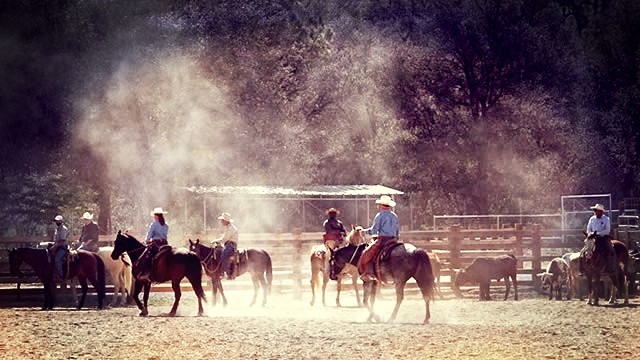“We’re working with different groups of the military,” says Bob King, Managing Director of Operations at Horse of the Sun Ranch. “One of the groups we work with is Semper Fi Fund.”
Horse of the Sun Ranch, is located in the foothills of the Cuyamaca Mountains 45 miles east of San Diego, California. Bob and the Program Director, Suzi Zielinski, teach horsemanship, cattle working skills, and ranch roping to our military’s wounded veterans. The ranch is a nonprofit organization with the mission to provide a variety of equestrian and respite programs and activities to military families and underserved youth. They also help provide Life Wishes for the terminally ill.
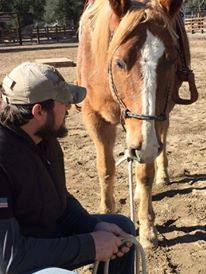 “We work with a colonel, John Mayer [for the Semper Fi Fund],” Bob says. “He brings a group out every month from September through May. So we have three different groups that we work with and rotate. What I do with them is I work on their horsemanship, and then I teach the ranch roping skills, cattle work—how to sort cattle, move cattle, doctor cattle. He [Mayer] wants them to have real life experiences so that it gives them opportunities.”
“We work with a colonel, John Mayer [for the Semper Fi Fund],” Bob says. “He brings a group out every month from September through May. So we have three different groups that we work with and rotate. What I do with them is I work on their horsemanship, and then I teach the ranch roping skills, cattle work—how to sort cattle, move cattle, doctor cattle. He [Mayer] wants them to have real life experiences so that it gives them opportunities.”
Semper Fi Fund is a non-profit organization that sponsors programs to assist wounded veterans in all branches of the United States Armed Forces.
“The one thing I see out of it a lot is that they [the vets] increase their power of concentration and are able to concentrate more,” Bob says. “We work with them on that and spend quite a bit of time to get them to where they can go to calf brandings. So we have worked a lot on the branding type of loops and position and things like that. They have a good time. What we’re trying to do is focus on training to help them that this could become a big part of their lives. They’re actually working doing things like that. They’ve got one they’re going to now in New Mexico in the first part of June. They’ll have a big cattle drive up there in Wyoming—they’ve done this for several years. They go in and work with a ranch, it’s about a four day deal where they actually help the cowboys put the cattle on the open range there for the summer time. The healing power of the horse for people is very unique.”
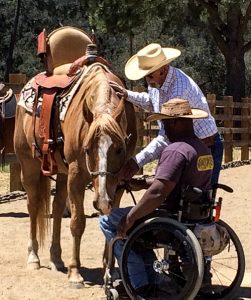 Bob’s name is known around horse circles in particular for his “Cowboy School,” a business he ran for many years with his wife Betty that was held in Arizona in winter and Wyoming in summer. He also traveled extensively teaching horsemanship and ranch roping clinics around the country. His Cowboy School in Wyoming was where the seed for Horse of the Sun Ranch was sown—it was there that he first met the ranch’s founders, Jerry Hall and Joe Cuffaro, and instilled in them the early inspiration for Horse Of The Sun Ranch.
Bob’s name is known around horse circles in particular for his “Cowboy School,” a business he ran for many years with his wife Betty that was held in Arizona in winter and Wyoming in summer. He also traveled extensively teaching horsemanship and ranch roping clinics around the country. His Cowboy School in Wyoming was where the seed for Horse of the Sun Ranch was sown—it was there that he first met the ranch’s founders, Jerry Hall and Joe Cuffaro, and instilled in them the early inspiration for Horse Of The Sun Ranch.
“My background goes back,” Bob says about his horsemanship. “I was introduced to Ray [Hunt] about a little over 30 years ago and I got to work with Tom [Dorrance] a little bit, and I’ve been to Buck [Brannaman] a tremendous amount, and I’ve been around Bryan Neubert quite a bit. Suzi [Zielinski] is coming on with a lot of Harry’s [Whitney] work. And we had a very interesting thing take place this spring—we had Wendy Murdoch come out and she worked. Wendy is going to be doing more of that for us.”
The horses in the Horse of the Sun Ranch program all are either Quarter Horses or Quarter Horse types. It takes around nine horses to run their sessions.
“Most all of them are older horses,” Bob says. “Some of them have been used for ranch work. Some of them have come out of reining or cutting programs. One used to do a little English hunting/jumping. They’re horses we can pick up and then we’ll go ahead and work with them to get them to where they fit our program. It takes a lot of ground work getting these horses used to different things. We have one paraplegic and he rides all the time and does extremely well. So we have to get these horses used to lots of different things and they’ve got to be pretty solid horses. Most of my job here is more on the teaching role. The main deal on the horses right now comes under Suzi.”
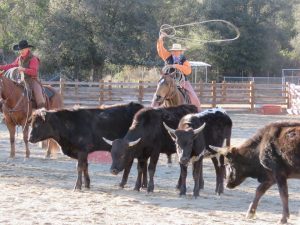 Suzi originates from San Diego, California and relocated to Cheyenne, Wyoming as an adult. She has taught clinics, worked with horses, and instructed folks in horsemanship for more than three decades. She recently gave up her horse training and instruction business in Wyoming to relocate back to the San Diego area to care for her father after he had a stroke. Suzi knew Bob from working in his ranch roping clinics in Colorado. She thought it would be difficult to start anew with her horse business in California, but when the opportunity with Bob opened up everything fell into place for her.
Suzi originates from San Diego, California and relocated to Cheyenne, Wyoming as an adult. She has taught clinics, worked with horses, and instructed folks in horsemanship for more than three decades. She recently gave up her horse training and instruction business in Wyoming to relocate back to the San Diego area to care for her father after he had a stroke. Suzi knew Bob from working in his ranch roping clinics in Colorado. She thought it would be difficult to start anew with her horse business in California, but when the opportunity with Bob opened up everything fell into place for her.
“We do a lot of ground work,” Suzi says. “In fact, if we don’t get on a horse the first day it’s not unusual. Asking for the horse to come forward or backing up—asking them to circle, breaking over the hind end. And they [the vets] just learn how to be with the horse. Most of them, if they do anything on the ground have a lot of driving in them, so we work on following a feel, helping them to really work on refining that feel. That takes some time. And then when they get up into the saddle, that’s when we work on the independent seat and getting the horse to listen to their leg cues, backing, finding a halt…all the basics. That gives me an understanding of what their background is in horsemanship. I provide a lot of support and help build up their confidence.”
Both men and women participate in the wounded veterans program.
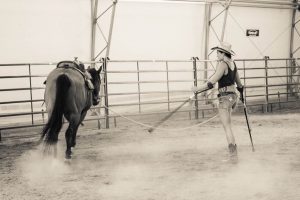 “A lot of them have had an extreme amount of combat,” Bob says. “You start to see the stress that they have gone through. They were trained to react it the war situations but take them out of that and this pressure builds. You see them come in and have a lot of ah-ha! moments as they’re working with the horse. A lot of them have had very little experience doing it, so as they work with the horses we talk about getting a horse hooked on you, understanding where the horse is, where his mind is, what little things can you do to draw his attention. We try to take it like we were doing a clinic and starting right there at ground zero—what they need to do to improve their horsemanship and be able to communicate with the horse.”
“A lot of them have had an extreme amount of combat,” Bob says. “You start to see the stress that they have gone through. They were trained to react it the war situations but take them out of that and this pressure builds. You see them come in and have a lot of ah-ha! moments as they’re working with the horse. A lot of them have had very little experience doing it, so as they work with the horses we talk about getting a horse hooked on you, understanding where the horse is, where his mind is, what little things can you do to draw his attention. We try to take it like we were doing a clinic and starting right there at ground zero—what they need to do to improve their horsemanship and be able to communicate with the horse.”
Bob and Suzi agree that they witness many benefits to the vets from working with the horses. When Suzi is asked how she would describe the success of the program she replies:
“Oh my gosh, since I’ve been involved the biggest success has been the interaction with building trust because these folks, their biggest problem is trusting humans and especially non-military people—and I don’t have a military background. We’re not there for psychology, we’re there to help them take this into their regular life. They’re there to learn how to be a group again. The Marines that are there, they’re used to being Marines—we have other military people too, but the Semper Fi group is basically Marines—they’re used to working together. They typically have real strong respect. Giving them respect they give you respect and it provides a great atmosphere for them and the horses.”
Suzi explains that when she began, the horses were very “out of balance both mentally and physically.” She attributes work she has done with Harry Whitney to having been the key to getting the horses mentally balanced which in turn has gone a long way to solving their overall balance issues.
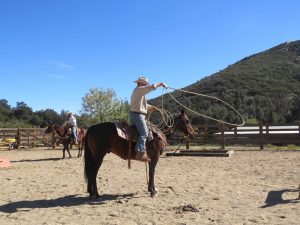 “The thing about these guys is for the most part they come back and ride the same horse and so they build a relationship with that horse and they notice how, ‘different he was than the first time I rode him and we’re working together more and I notice that we’re working together better.’ That’s good to hear. That helps build their confidence that they’re getting better with the horse. I know it’s because they’re getting more responsive and it’s good to see that change.
“The thing about these guys is for the most part they come back and ride the same horse and so they build a relationship with that horse and they notice how, ‘different he was than the first time I rode him and we’re working together more and I notice that we’re working together better.’ That’s good to hear. That helps build their confidence that they’re getting better with the horse. I know it’s because they’re getting more responsive and it’s good to see that change.
“I think the biggest part is that these guys are learning to use what they’ve learned being in the military and how important that is to them. They start learning how to work as a team and that whole combination of working as a team on the ranch is so important. It’s very important to Bob that everybody stay safe and at the same time enjoys themselves. So they’re learning how to be safe and how important it is to take it slow mentally for the horses and the cows, and these guys coming from that adrenaline rush that they’re used to are learning how to take it calm. So they are learning so many different coping skills—that’s the best part.”
Learning patience and learning that they can do many new things is a very important aspect of the program, according to Bob.
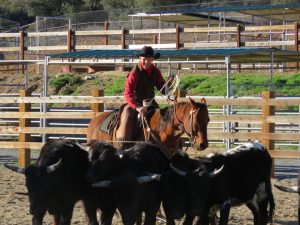 “This is where I really enjoy the cattle work with them,” Bob says. “I’ll set up an obstacle course and work the cattle through it. If they come in with too much energy the cattle just scatter all over. So, they learn to slow down. And I think what it does is help them learn to calm themselves down internally. It really seems to just slow things down for them and help them where they develop patience, get that calmness, and they’re able to go from there. It’s really a close knit group. These people have given so much to all of us. We appreciate their service and to be able to help give back is a pretty neat deal.”
“This is where I really enjoy the cattle work with them,” Bob says. “I’ll set up an obstacle course and work the cattle through it. If they come in with too much energy the cattle just scatter all over. So, they learn to slow down. And I think what it does is help them learn to calm themselves down internally. It really seems to just slow things down for them and help them where they develop patience, get that calmness, and they’re able to go from there. It’s really a close knit group. These people have given so much to all of us. We appreciate their service and to be able to help give back is a pretty neat deal.”

